|
|

This chapter provides physical and functional overviews of the Cisco AccessPath-TS3 Model 531 Integrated Access System.
This chapter includes the following sections:
The Cisco AccessPath-TS3 Model 531 Integrated Access System is a scalable, high-density dial system designed to terminate a large number of incoming mixed digital Integrated Services Digital Network (ISDN) and analog calls. The Cisco AccessPath-TS3 Model 531 system provides dial access for service providers deploying large-scale (140 or more) hybrid access ports at a central site. Through its distributed architecture, the system supports remote node or remote local area network (LAN) applications using either asynchronous modem or ISDN technology.
The Cisco AccessPath-TS3 Model 531 system provides a remote access solution for the inter-exchange carrier (IXC), regional Bell operating company (RBOC), Internet service provider (ISP), competitive access provider (CAP), and large Enterprise markets. It integrates high-end access servers, Ethernet switches, and routers into a single Electronic Industries Association (EIA)-standard rack cabinet.
The Cisco AccessPath-TS3 Model 531 system accommodates both scalable dial-port counts and high-performance backbone routing in a distributed system architecture. The enhanced performance meets the reliability and serviceability requirements of point-of-presence (POP) administrators, enabling them to minimize downtime and service costs.
Processing tasks—such as answering and terminating calls—are divided among several CPUs, increasing overall system call processing and throughput performance. By providing alternate data paths from each access server to 1 or 2 high-distribution routers, the Cisco AccessPath-TS3 Model 531 system provides full redundancy for mission-critical data.
The Cisco AccessPath-TS3 Model 531 system integrates the latest access server, switching, and advanced routing features of Cisco IOS software. Its built-in System Controller facilitates the management and remote configuration of the system.


Warning Ultimate disposal of this product should be handled according to all national laws and regulations.
The Cisco AccessPath-TS3 Model 531 Integrated Access System comes in 4 standard configurations:
Each configuration is built around a Cisco-specified switching and routing infrastructure, which can be expanded in order to support greater call volumes. The more powerful your infrastructure, the greater the number of Cisco AS5300 access servers you can install in your system, thereby expanding your capacity to handle incoming calls.
You can scale your existing Cisco AccessPath-TS3 Model 531 system configuration by adding a Catalyst 5002 switch, a Cisco 7206 router, or multiple Cisco AS5300 access servers to your system. You can fully upgrade from one configuration to another, or modify an existing configuration by adding Cisco AS5300 access servers.
Each configuration contains a switched infrastructure, using different combinations of Cisco's Ethernet switching module and the Catalyst 5002 switch. The switched system fabric speeds the processing of incoming requests, and transfers them to the Cisco 7206 router or routers.
All configurations include:
A Cisco 3640 System Controller provides console management functions for the Cisco AccessPath-TS3 Model 531 system, while multiple Cisco AS5300 access servers supply the dial front-end interface. Each access server contains a series of ports arrayed as points of entry for calls arriving at your site.
Depending upon the configuration, either 1 or 2 Router Shelves are installed in the system. These provide process server and backhaul functions. The routers also provide load balancing when demand is heavy; in Midrange and High-End configurations, the presence of 2 Router Shelves leads to the activation of a failover path should a single router fail.
The following sections describe each of the 4 Cisco AccessPath-TS3 Model 531 system configurations in more detail.
The Cisco AccessPath-TS3 Model 531 system Entry configuration contains:
The primary data paths run from the access server ports to the primary dual Ethernet switch module using full duplex autosensing 10BaseT ports. The switch uses Fast Ethernet (100BT) to transmit data to the Router Shelf router.
The Entry configuration is the base system configuration for the Cisco AccessPath-TS3 Model 531 system. You can upgrade within its defined parameters by adding Access Server Shelves until you reach a total of 7, or upgrade (scale) to the Midrange configuration by adding a Switch Shelf.
In addition to what is included with the Entry configuration (a Cisco 3640 System Controller, a single Cisco 7206 router), the Midrange configuration for the Cisco AccessPath-TS3 Model 531 system includes a Catalyst 5002 switch. The Midrange configuration can support 2 to 11 Cisco AS5300 access servers.
The Cisco AccessPath-TS3 Model 531 system Midrange configuration consists of:
In a Midrange configuration, the Catalyst 5002 switch provides the system's primary switching services. It can deliver more than 1 million pps (packets per second) throughput across a 1.2-Gbps backplane; the 24-port 10/100BaseT line card meets all 3T3 connectivity and switching requirements. The greater capacity of the Catalyst 5002 speeds the processing of incoming requests.
In addition to what is included with the Midrange configuration (a Cisco 3640 System Controller, a single Cisco 7206 router, and a Catalyst 5002 switch), the High-End configuration for the Cisco AccessPath-TS3 Model 531 system includes a second Cisco 7206 router. The High-End configuration can support 2 to 14 Cisco AS5300 access servers.
The addition of a second Cisco 7206 router provides load balancing for greater processing efficiency and system-level failover. The greater data processing power it provides allows for the addition of Cisco AS5300 access servers beyond the 11-access server limit of the Midrange configuration (to a limit of 14).
The Cisco AccessPath-TS3 Model 531 system High-End configuration consists of:
These components comprise the High-End Extended Configuration:
The placement and numbering of the Access Server Shelves is shown in Figure 1-2.
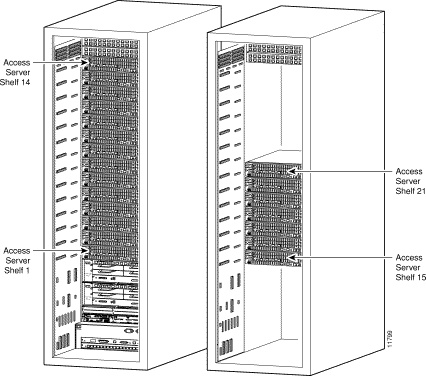
The Cisco AccessPath-TS3 Model 531 system includes the following features:
The Cisco AccessPath-TS3 Model 531 system arrives preracked, precabled, and preconfigured with default configurations. The preconfiguration is intended to improve customer success during system setup and reduce installation and operation costs. A great deal of the cost of any dial point-of-presence (POP) comes from the need to physically design, integrate, and test the equipment involved.
Each Cisco AccessPath-TS3 Model 531 system comes with a System Controller that provides console management of each device in the cabinet. This adds resiliency to the system by allocating a direct out-of-band console connection to every Cisco AccessPath-TS3 Model 531 system shelf.
You can use a terminal connection to the System Controller, command-line interface (CLI), and supplied custom or sample (typical) configurations to configure individual devices. You can also use AccessPath Manager (APM) software to configure system devices.
See the Cisco AccessPath-TS3 Integrated Access System Software Configuration Guide or the Cisco AccessPath Manager Configuration Guide to simplify software configuration.
The Cisco AccessPath-TS3 Model 531 system has no single point of failure. Operating time is maximized and the failure of individual components will not bring down the entire system. This applies to all Cisco AccessPath-TS3 Model 531 system configurations.
The Cisco AccessPath-TS3 Model 531 system provides guaranteed compatibility to networks that run Cisco IOS software. Cisco IOS software runs on most of the world's internetworks, both on Cisco routers and on many partners' platforms. Customers can leverage their current training and experience with Cisco IOS software to install, configure, and manage the Cisco AccessPath-TS3 Model 531 system.
Refer to the Cisco AccessPath-TS3 Integrated Access System Software Configuration Guide and the Release Notes for the Cisco AccessPath-TS3 Integrated Access System for additional information on Cisco IOS software in the Cisco AccessPath-TS3 Model 531 system.
With access servers, an Ethernet switch, and high-performance routers integrated into 1 system, the Cisco AccessPath-TS3 Model 531 system avoids incompatibility concerns that normally plague multivendor or multibox installations. The Cisco AccessPath-TS3 Model 531 system is precabled and individual components are configured with sample (typical) configurations, thereby guaranteeing interoperability.
You can scale your Cisco AccessPath-TS3 Model 531 system configuration to fit the changing needs of your company. It is possible to upgrade from 1 configuration to another; for instance, to scale from an Entry configuration to a Midrange configuration, or from a Midrange to a High-End configuration. You can even skip configuration levels when scaling; for instance, you can upgrade a Midrange system configuration to a High-End Extended configuration.
You can also upgrade an existing configurations without changing infrastructure devices by adding Cisco AS5300 access servers to expand incoming call handling capability. Alternately, you can upgrade the infrastructure devices without adding access servers, then add Cisco AS5300 access servers at a later time.
The Cisco AccessPath-TS3 Model 531 system's modular cabinet architecture also enables the rapid implementation of new technologies and hot swapping of new hardware components as they become available.
In addition to hardware scalability, the Cisco AccessPath-TS3 Model 531 system also includes software scalability through Cisco IOS software. The most common applications for which the Cisco AccessPath-TS3 Model 531 system is utilized are available as 3 orderable options:
T1 or E1 lines, supporting either ISDN PRI or channel-associated signaling (CAS), feed into the Cisco AccessPath-TS3 Model 531 system's Access Server Shelves. Each Access Server Shelf supports 4 T1/E1 connections. With a maximum configuration of 21 Access Server Shelves, the Cisco AccessPath-TS3 Model 531 system can accommodate up to 84 T1 or E1 connections.
| Connection | Interface | Maximum Number of Calls (21 Access Server Shelves) | Call Type |
|---|---|---|---|
T1
| PRI | 1932 | Analog or ISDN |
CAS1 a | 2016 | Analog | |
E1
| PRI | 2520 | Analog or ISDN |
CAS b | 2520 | Analog |
| 1CAS = Channel-Associated Signalling. |
An Access Server Shelf supports 4 T1/E1 connections. The calls arrive at the Cisco AS5300 access server ports and are sent on to the Switch Shelf, aggregated, multiplexed, and sent over a 100BaseT Fast Ethernet connection to the Router Shelf.
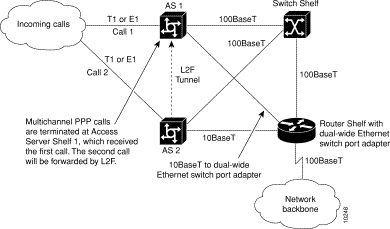
Figure 1-4 shows a Cisco AccessPath-TS3 Model 531 system Entry configuration set up for single-channeled interfaces.
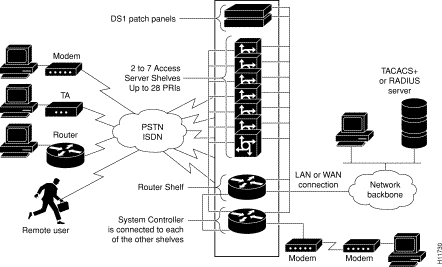
If a PPP session analog call comes in to an Access Server Shelf from the cloud, it is framed and forwarded (multiplexed) to the Switch Shelf and forwarded to the Router Shelf.
Figure 1-5 illustrates a typical ISP environment using multichassis multilink PPP (MMP).

From the Router Shelf, customers can route calls to a wide variety of services. Calls can be routed to a WAN, or to another switch. If calls are forwarded through a WAN to a home gateway, the Router Shelf acts solely as a conduit, passing the data on to the home gateway where the call is answered.
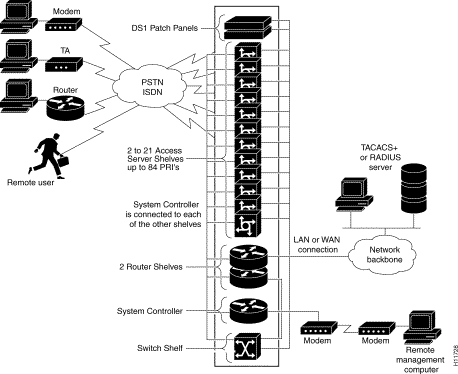
This section describes the physical characteristics of these components in their relationship with 1 another as part of the Cisco AccessPath-TS3 Model 531 system. For more information about each of these components, refer to the documents listed in the section "Related and Referenced Documents" in the preface "About this Guide."
The Cisco AccessPath-TS3 Model 531 system includes the following components:
| Description | Specification |
|---|---|
Dimensions:
|
79.5 x 25.9375 x 32 in. (201.93 x 55.89 x 81.28 cm) 79.5 x 25.9375 x 30 in. (201.93 x 55.89 x 76.2 cm) |
Weight (per cabinet) |
|
| |
DC Power: | |
Operating environment | 32 to 104ºF (continuous operation) (0 to 40ºC) |
Non-operating temperature | -4 to 149ºF (-20 to 65ºC) |
Operating humidity | 10 to 85%, noncondensing |
Regulatory compliance | FCC Part 15 Class A. NEBS Standard Certification. For additional compliance information, refer to the regulatory compliance and safety information document that accompanied the Cisco AccessPath-TS3 Model 531 system. |
| 1A = amperes. 2W = watts. |
This section provides the Cisco AccessPath-TS3 Model 531 system specifications on a configuration-by-configuration basis. Parameters such as system weight and power usage will vary depending upon the particular configuration.
| Description | Specification |
|---|---|
Dimensions:
|
79.5 x 25.9375 x 32 in. (201.93 x 55.89 x 81.28 cm) 79.5 x 25.9375 x 30 in. (201.93 x 55.89 x 76.2 cm) |
699 pounds (318 kg) | |
AC Power: | |
DC Power: | |
Operating environment | 32 to 104ºF (continuous operation) (0 to 40ºC) |
Non-operating temperature | -4 to 149ºF (-20 to 65ºC) |
Operating humidity | 10 to 85%, noncondensing |
Regulatory compliance | FCC Part 15 Class A. NEBS Standard Certification. For additional compliance information, refer to the regulatory compliance and safety information document that accompanied the Cisco AccessPath-TS3 Model 531 system. |
| Description | Specification |
Dimensions:
|
79.5 x 25.9375 x 32 in. (201.93 x 55.89 x 81.28 cm) 79.5 x 25.9375 x 30 in. (201.93 x 55.89 x 76.2 cm) |
Weight | 912 pounds (414 kg) |
AC Power: | |
DC Power: | |
Operating environment | 32 to 104ºF (continuous operation) (0 to 40ºC) |
Nonoperating temperature | -4 to 149ºF (-20 to 65ºC) |
Operating humidity | 10 to 85%, noncondensing |
Regulatory compliance | FCC Part 15 Class A. NEBS Standard Certification. For additional compliance information, refer to the regulatory compliance and safety information document that accompanied the Cisco AccessPath-TS3 Model 531 system. |
| Description | Specification |
|---|---|
Dimensions:
|
79.5 x 25.9375 x 32 in. (201.93 x 55.89 x 81.28 cm) 79.5 x 25.9375 x 30 in. (201.93 x 55.89 x 76.2 cm) |
Weight | 1058 pounds (481 kg) |
AC Power: | |
DC Power: | |
Operating environment | 32 to 104ºF (continuous operation) (0 to 40ºC) |
Non-operating temperature | -4 to 149ºF (-20 to 65ºC) |
Operating humidity | 10 to 85%, noncondensing |
Regulatory compliance | FCC Part 15 Class A. NEBS Standard Certification. For additional compliance information, refer to the regulatory compliance and safety information document that accompanied the Cisco AccessPath-TS3 Model 531 system. |
| Description | Specification |
|---|---|
Dimensions:
|
79.5 x 25.9375 x 32 in. (201.93 x 55.89 x 81.28 cm) 79.5 x 25.9375 x 30 in. (201.93 x 55.89 x 76.2 cm) |
1732 pounds (787 kg) total for 2 cabinets | |
AC Power: | |
DC Power: | |
Operating environment | 32 to 104ºF (continuous operation) (0 to 40ºC) |
Non-operating temperature | -4 to 149ºF (-20 to 65ºC) |
Operating humidity | 10 to 85%, noncondensing |
Regulatory compliance | FCC Part 15 Class A. NEBS Standard Certification. For additional compliance information, refer to the regulatory compliance and safety information document that accompanied the Cisco AccessPath-TS3 Model 531 system. |
The Cisco AccessPath-TS3 Model 531 system has a single 19-in. (48.3 cm) rack-designed cabinet (79.5 in. [202 cm] high) that accommodates up to 1344 simultaneous callers terminated in a single T1-configured cabinet (up to 1680 in an E1-configured cabinet).
The types of interfaces are:
The Cisco AccessPath-TS3 Model 531 system also supports NxT1 and NxCT1 for dedicated connections.
Additional specifications for the individual shelves that make up the Cisco AccessPath-TS3 Model 531 system are detailed in the sections that follow.
The System Controller ports provide basic and emergency remote system access (via an auxiliary port on the rear of the unit), and serial WAN, Ethernet and Token Ring connections. The serial WAN connections use a proprietary, 60-pin connector, while the Ethernet and Token Ring connections use standard LAN cabling with an attachment unit interface (AUI) or DB-9 connector.
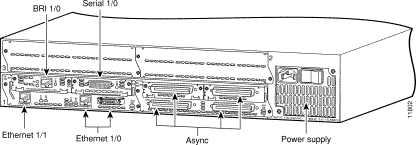
The System Controller has the following hardware features:
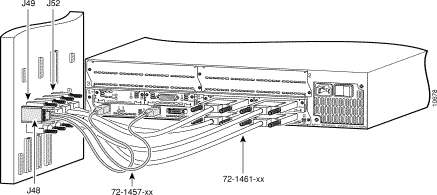
Specifications for the System Controller are listed in Table 1-7. For more information on agency compliace, refer to the document Regulatory Compliance and Safety Information for the Cisco AccessPath-TS3 Integrated Access System.
| Description | Specification |
|---|---|
Dimensions (H x W x D) | 3.5 x 17.5 x 15 in. (8.89 x 44.45 x 38.10 cm) (2 rack units) |
Weight | 10 lb (4.5 kg) |
AC Power: | |
DC Power: | |
Network interface options | Ethernet, serial, Token Ring, BRI, (S/T and U interfaces), T1/PRI, E1/PRI |
Serial interfaces | EIA/TIA2-232, EIA/TIA-449, V.35, X.21, NRZ3/NRZI, DTE/DCE4, and EIA-530 DTE. |
Console and auxiliary ports | RJ-45 connector |
Operating humidity | 5 to 95%, non-condensing |
Operating temperature | 32 to 104°F (0 to 40°C) (continuous) |
Non-operating temperature | -40 to 185°F (-40 to 85°C) |
Noise level | 51.9 dB5 maximum |
Regulatory compliance | FCC Part 15 Class B. For additional compliance information, refer to the Regulatory Compliance and Safety Information document that accompanied the Cisco AccessPath-TS3 Model 531 system. |
Each Access Server Shelf (Figure 1-9) consists of the following components:

See Figure 1-10 for an illustration of the Access Server Shelf cabled into the Cisco AccessPath-TS3 Model 531 system.
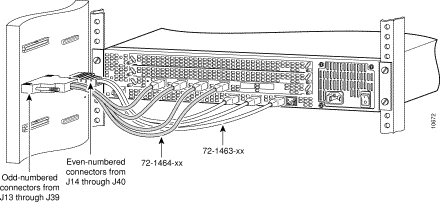
The specifications of the Access Server Shelf are listed in Table 1-8. For more information on agency compliance, refer to the document Regulatory Compliance and Safety Information for the Cisco AccessPath-TS3 Integrated Access System.
| Description | Specification |
|---|---|
Dimensions (H x W x D) | 3.5 x 17.5 x 18.25 in. (8.89 x 44.45 x 46.36 cm) |
32 lb maximum (14.5 kg) | |
150 MHz | |
32 to 104ºF (0 to 40ºC) | |
-40 to 185ºF (-40 to 85ºC) | |
5 to 95%, noncondensing | |
70 dB @ 3 ft (0.914 m) | |
AC Power: | |
DC Power: | |
Quad T1/PRI (RJ-45) | |
Ethernet 10BaseT (RJ-45) | |
Synchronous serial interfaces (5-in-1 synchronous serial WAN ports) | EIA/TIA-232, EIA/TIA-449, V.35, X.21 (NRZ/NRZI and DTE/DCE mode) |
Asynchronous serial (RJ-45) | |
Alarm relay rating: | |
Regulatory compliance | FCC Part 68. See also the Regulatory Compliance and Safety Information document that shipped with the Cisco AccessPath-TS3 Model 531 system. |
The Router Shelf provides the following features:
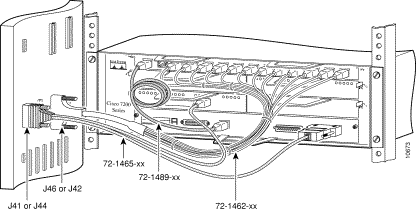
The Router Shelf comes equipped with the following components:
The front of the Router Shelf provides access to an I/O controller and up to 6 network interface port adapters. (See Figure 1-12.)
The I/O controller contains the following:
The Fast Ethernet port provides a 100-Mbps connection to the network.
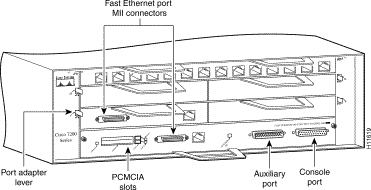
The port adapters installed in the Router Shelf support online insertion and removal (OIR).
Network interfaces reside on port adapters that provide the connection between the router's 3 Peripheral Component Interconnect (PCI) buses and external networks. The Router Shelf has 6 port adapter slots, 1 slot for an Input/Output (I/O) controller, and a single slot for a network processing engine.
Port adapter slots in the Router Shelf are numbered from left to right, beginning with port adapter slot 1 and continuing through port adapter slot 6. Port adapter slot 0 is the Fast Ethernet port on the I/O controller. (See Figure 1-13.)
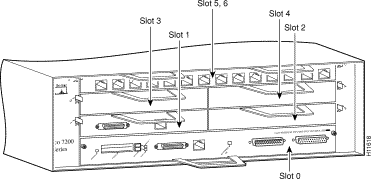
The port adapters installed in the slots of the Router Shelf differ depending on your system configuration.
See Table 1-9 for more information on the standard port adapter configurations for the 4 Cisco AccessPath-TS3 Model 531 system configurations. (The blank slots may be used for sending traffic to your backbone network.)
| Configuration | Shelf | Port Adapter Slot Configuration |
|---|---|---|
Entry | Router Shelf 1 | Slot 1—Fast Ethernet Slot 2—Blank or optional backhaul Slot 3—Cisco Ethernet switching port adapter (PA-12E/2FE) (primary) Slot 4—Cisco Ethernet switching port adapter (PA-12E/2FE) (primary Slot 5—Cisco Ethernet switching port adapter (PA-12E/2FE) (failover) Slot 6—Cisco Ethernet switching port adapter (PA-12E/2FE) (failover) |
Midrange, High-End, or High-End Extended1 | Router Shelf 1 | Slot 1—Fast Ethernet Slot 2—Blank or optional backhaul Slot 3—Blank or optional backhaul Slot 4—Blank Slot 5—Cisco Ethernet switching port adapter (PA-12E/2FE) (failover) Slot 6—Cisco Ethernet switching port adapter (PA-12E/2FE) (failover) |
Router Shelf 2 | Slot 1—Fast Ethernet Slot 2—Blank or optional backhaul Slot 3—Blank or optional backhaul Slot 4—Blank Slot 5—Cisco Ethernet switching port adapter (PA-12E/2FE) (failover) Slot 6—Cisco Ethernet switching port adapter (PA-12E/2FE) (failover) |
The rear of the Router Shelf provides access to the network processing engine and up to 2 power supplies. (See Figure 1-14.)
There are bays for up to 2 AC- or DC-input power supplies. The Router Shelf will operate with 1 power supply. A second power supply is shipped with the Cisco AccessPath-TS3 Model 531 system to provide rudiment power should 1 power supply fail. The Router Shelf does not support a mixture of AC- and DC-input power.
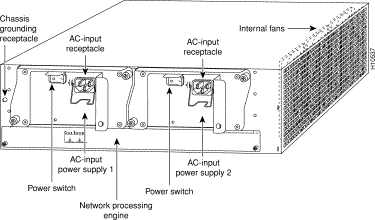
Table 1-10 lists the Cisco 7206 router specifications and power requirements. For more information on agency compliance, see the document Regulatory Compliance and Safety Information for the Cisco AccessPath-TS3 Integrated Access System.
| Description | Specification |
|---|---|
Midplane | 2 primary PCI buses and 1 secondary PCI bus with an aggregate bandwidth of 600 Mbps |
Dimensions | 10.50 x 16.8 x 17 in. (26.67 x 42.67 x 43.18 cm) |
Weight | Chassis fully configured with a network processing engine, I/O controller, 6 port adapters, 2 power supplies, and a fan tray: ~ 50 lb (22.7 kg) |
Heat dissipation | 430W (1500 BTU) |
DC-input voltage
DC-input current rating | -48 VDC nominal in North America -60 VDC nominal in the Europe Community |
13A maximum at -48 VDC 8A maximum at -60 VDC | |
AC-input voltage AC-input current rating | 100 to 240 VAC |
5A | |
Frequency | 50/60 Hz |
Airflow | ~80 cfm1 |
Temperature | 32 to 104° F (0 to 40° C) operating; -4 to 149° F (-20 to 65° C) nonoperating |
Humidity | 10 to 90% noncondensing |
Minimum software requirements | Cisco IOS Release 11.1(5) or later for a Cisco 7206 with the following: NPE2-150
Cisco IOS Release 11.1(13a)CA1 or later for a Cisco 7206 with an installed NPE-300 Cisco IOS Release 11.1(16)CA or later for a Cisco 7206 with an installed I/O controller with the Fast Ethernet port that is equipped with an MII receptacle and an RJ-45 receptacle |
Agency approvals | Safety: UL 1950, CSA 22.2 No. 950, EN60950, AUSTEL TS001, |
| 1cfm = cubic feet per minute. 2NPE = network processing engine. |
The Catalyst 5002 Switch Shelf has a 1.2-Gbps media-independent switch fabric. The backplane provides the connection between power supplies, supervisor engine modules, interface modules, and the backbone module. The Switch Shelf supports switched 10-megabit-per-second (Mbps) Ethernet, Ethernet repeater connections, stored and switched 100-Mbps Fast Ethernet using unshielded twisted-pair (UTP) connections.
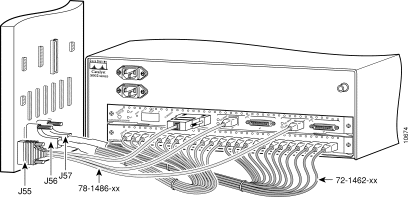
Typically, Switch Shelf Ethernet interfaces connect workstations and repeaters; the Fast Ethernet interfaces connect to workstations, servers, switches, and routers.
The Switch Shelf consists of the following components:
The Switch Shelf provides the following high-level features:
The Cisco AccessPath-TS3 Model 531 system Switch Shelf supervisor engine module provides the following functionality:
The Switch Shelf chassis has 2 slots. The top slot contains the supervisor engine module, which provides switching, local and remote management, and dual Fast Ethernet interfaces. The bottom slot contains the Fast Ethernet module.
The backplane module provides the connection between the supervisor engine module, interface modules, and power supplies. (See Figure 1-16.)
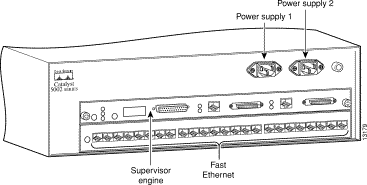
The Switch Shelf backplane has no active components that could fail; it is completely passive. All interfaces are accommodated in a 19-inch rack. The switch supports single or redundant AC- or DC-input power supplies.
| Description | Specification |
|---|---|
Dimensions (H x W x D) | 5.25 x 17.21 x 18.14 in. (13.3 x 42.5 x 44.5 cm) |
Weight | 43 lb (19.5 kg) minimum |
AC-input voltage | 100 to 240 VAC1 wide input with power factor correction |
AC-input current rating | 5A2 maximum at 90 to 132 VAC |
AC-power dissipation | 215W maximum configuration |
DC-input power | 370W maximum (with either a single or dual power supply configuration) |
DC-input voltage | -48 VDC to -60 VDC continuous |
DC-input current rating |
6A max @ -48 VDC (nominal) 4A max @ -60 VDC (nominal) |
Processor | 25-MHz Motorola 68EC040 |
LAN interfaces | 10BaseT Ethernet |
Regulatory Compliance | FCC Part 15 Class B. For additional compliance information, refer to the Regulatory Compliance and Safety Information document that accompanied the Cisco AccessPath-TS3 Model 531 system. |
| 1VAC = volts alternating current. 2A = ampere. |
![]()
![]()
![]()
![]()
![]()
![]()
![]()
![]()
Posted: Tue Jul 16 15:02:22 PDT 2002
All contents are Copyright © 1992--2002 Cisco Systems, Inc. All rights reserved.
Important Notices and Privacy Statement.